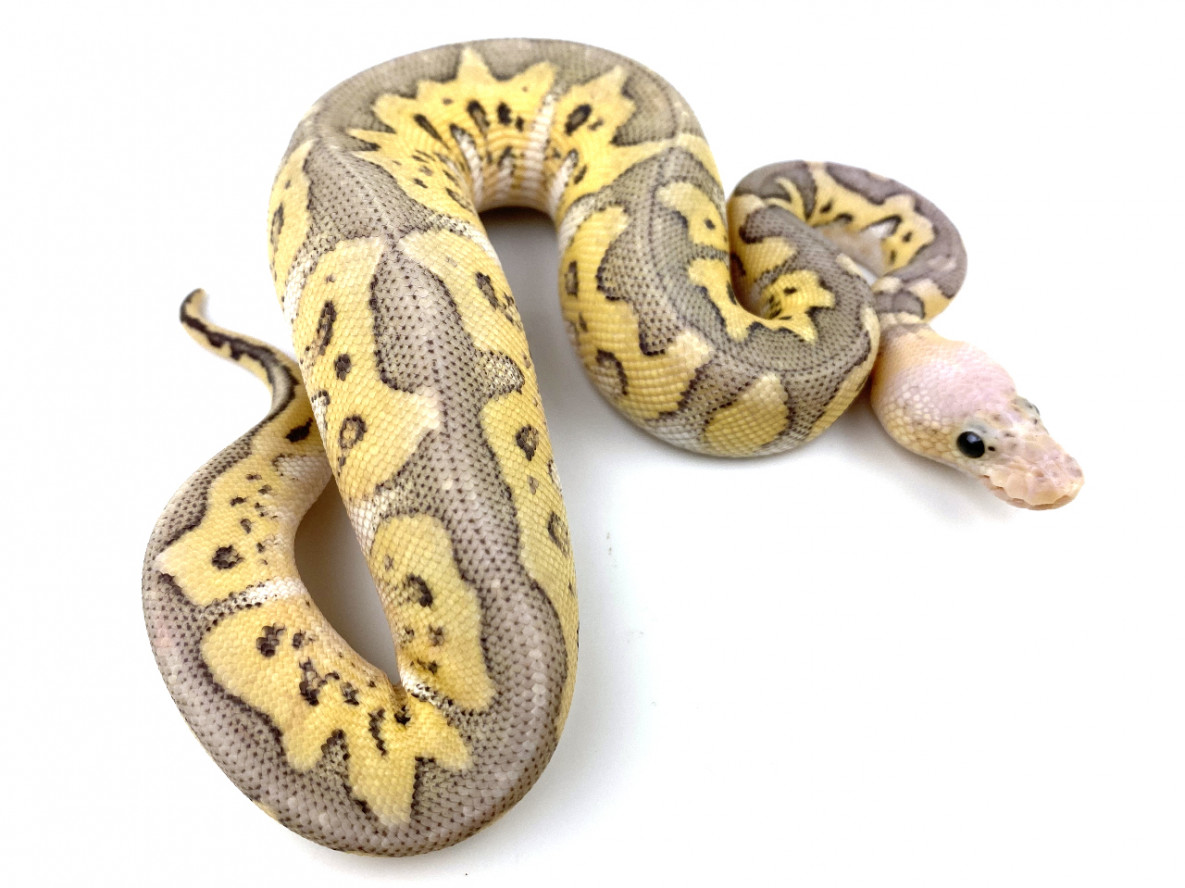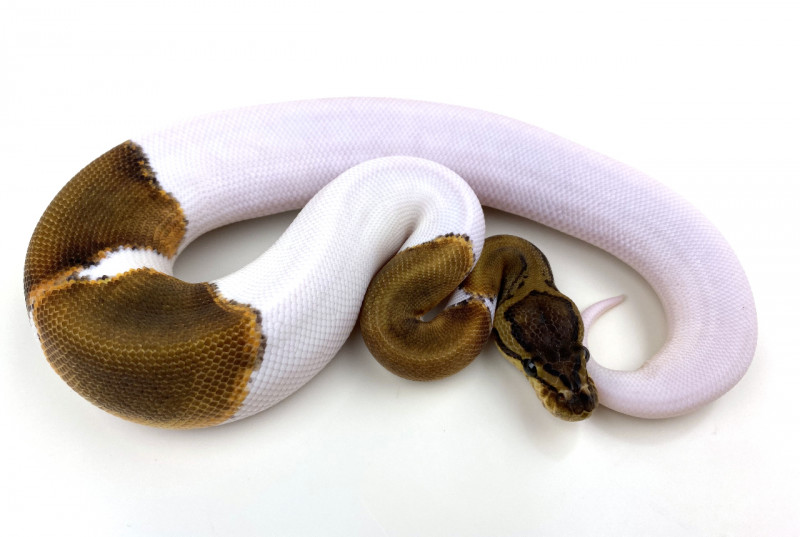Ball Python Genetics
There is no animal on earth that has shown as much genetic variation as ball pythons.

Ball pythons are available in Thousands Of Different colors and pattern combinations.
There is no animal on earth that has shown as much genetic variation as ball pythons. Some of the earlier morphs originated from wild-caught or farm-raised snakes in Africa in the 1990s. Odd-colored or patterned ball pythons were occasionally found and offered to breeders in the US. Examples of these early morphs are albino, hypo, clown, caramel albino, axanthic, piebald, and pastel. As the demand for rare color morphs rose, more morphs were discovered and made their way into captive-breeding collections. Most of these morphs sold for tens of thousands of dollars when the first babies became available. As more of them were produced, their prices dropped. However, every year, new morphs are produced by combining some of the existing morphs and occasionally, a new morph is found in Africa and becomes established in collections.
Every year, new combinations are added together to produce new morphs. We’ve probably produced over (probably well over!) 40 “world’s firsts” Ball Python Morphs! Keeping up with all of the new combinations can be very difficult, even for someone who does it full-time! It is extremely important to understand the genetics behind these morphs, in order to figure out how to combine them to reproduce them, or to produce new ones. The information below is a very brief overview of leopard gecko genetics:
Terminology:
Heterozygous (het)- A ball that is listed as a "het" means it is carrying a recessive gene, but not visibly expressing it. When bred to other ball pythons showing or carrying the same recessive gene, the visible morph can be produced.
Normal (wild-type) ball python is the dominant type.
Normal x Normal = all Normals
Simple-recessive
Example: Albino
Albino x Albino = all Albino
Albino x Het Albino = 1/2 Albinos and 1/2 Het Albinos
Albino x Normal = all Het Albinos
Het Albino x Het Albino = 1/4 Albinos, 1/4 Normals, and 1/2 Het Albinos. 3 out of 4 babies will come out looking normal, and 2 out of those 3 should come out Hets, so all normal-looking babies would be considered 66% Possible Hets.
Double Recessive:
Combining 2 different recessive genes.
Example: Albino and Piebald
Albino x Piebald = all normals that are Het Albino and Het Piebald- considered Double Het Albino Piebald. You have to breed these double hets to each other to produce a snake that shows both Albino and Piebald traits at the same time- an Albino Piebald.
Double Het Albino Piebald x Double Het Albino Piebald will produce normals, albinos, and piebalds. Each egg has a 1 in 16 chance of producing an Albino Piebald.
Dominant:
Example: Spider
Spider x Normal = 1/2 Spiders and 1/2 Normals
Spider x Spider = all Spiders
Dominant x Recessive:
Dominant Example: Spider
Recessive Example: Albino
Spider x Albino = 1/2 Spider Het Albinos and 1/2 Normal Het Albinos
To produce Albino Spiders, you have to breed the following:
Spider Het Albino x Albino = 1/4 Spider Het Albinos, 1/4 Normal Het Albinos, 1/4 Albinos, and 1/4 Spider Albinos
Co-dominant (incomplete-dominant):
This type is dominant to the normal, meaning you can breed it to normals and produce some snakes showing the morph. There is also a super form of co-dominant morphs.
Example: Pastel
Pastel x Normal = 1/2 Pastels and 1/2 Normals
Pastel x Pastel = 1/4 Normals, 1/2 Pastels, and 1/4 Super Pastels
Super Pastel x Normal = all Pastels
Super Pastel x Pastel = 1/2 Pastels and 1/2 Super Pastels
Super Pastel x Super Pastel = all Super Pastels
Dominant x Co-Dominant:
Dominant Example: Spider
Co-Dominant Example: Pastel
Spider x Pastel = 1/4 Normals, 1/4 Spiders, 1/4 Pastels, and 1/4 Bumblebees (Pastel Spiders)
Super Pastel x Spider = 1/2 Pastels x 1/2 Bumblebees
Bumblebee x Pastel = Normals, Pastels, Super Pastels, Bumblebees, and Killerbees (Super Pastel Spiders)
KillerBee x Pastel=Pastels, Super Pastels, Bumblebees, and Killerbees
Co-Dominant x Recessive:
Co-Dominant Example: Pastel
Recessive Example: Piebald
Pastel x Piebald = 1/2 Pastels and 1/2 Normals, all of which are Het Piebald.
To produce a ball showing both the Pastel AND Piebald, the one of the following breedings must be done:
Pastel Het Piebald x Piebald = 1/4 Normal Het Piebalds, 1/4 Pastel Het Piebalds, 1/4 Piebalds, and 1/4 Pastel Piebalds.
Pastel Het Piebald x Pastel Het Piebald = Normals , Pastels, Super Pastels, Piebalds, Pastel Piebalds, and Super Pastel Piebalds. All non-Piebalds in this combination would be considered 66% possible het Piebald.
Pastel Piebald x Pastel Het Piebald = Normal Het Piebald, Pastel Het Piebald, Super Pastel Het Piebald, Piebald, Pastel Piebald, and Super Pastel Piebald.
Super Pastel Piebald x Pastel Piebald = 1/2 Pastel Piebald and 1/2 Super Pastel Piebald
Super Pastel Piebald x Super Pastel Het Piebald = 1/2 Super Pastel Het Piebald and 1/2 Super Pastel Piebald.
Super Pastel Piebald x Super Pastel Piebald = all Super Pastel Piebalds
Keep in mind that these are statistical averages. There can be variations within any given clutch of eggs. The more clutches that are produced, the more likely the ratios are likely to come out correct.
There are more complicated scenarios with double or triple recessives crossed with double or triple co-dominants. Every generation where new combinations are bred together, genetics can get more and more complicated!
Other interesting facts about ball python genetics:
Banana vs Coral Glow: Banana and Coral Glows are genetically the same morph. The original “banana” was imported and named by one breeder, and the original “coral glow” was imported and named by another breeder. They came from the same African source and are thought to be directly related to each other.
Banana/Coral Glow male-maker vs female-maker: This gene is complicated, because some male bananas will make mostly male bananas and female non-bananas, and others are the opposite. Here is how it works:
Female Bananas will produce an equal ratio of male and female bananas and male and female non-bananas. A male banana produced from a female banana will produce mostly female bananas and male non-bananas. He is considered to be a female-maker. However, if he produces a male, that male becomes a male-maker. About 90% of his banana offspring will be males (male-makers) and about 90% of his non-banana offspring will be female. Only male bananas can be male-makers or female-makers. Female bananas will produce both males and females.
Blue Eye Leucistic Complex: There are several morphs of ball pythons that are very closely related, which are capable of producing Blue Eye Leucistics. Mojaves, Lesser Platinums, Butters, and Russo-line Het Leucistics will all produce Leucistics when bred to the same morph or to any of the others listed. The Mojave x Mojave Leucistics tend to have darker heads and a little more body coloration, but the other combinations are usually pure white. Bamboo is also a member of this complex and will produce various blue-eyed leucistics when bred to other members of the complex
Butters and Lessers are basically the same morph. There is some variation within the morph and between the morphs, but they physically look pretty much the same and both produce leucisitcs.
Cinnamons vs Black Pastels: These two morphs have some differences, but look pretty similar overall. They are closely related, though. Super Black Pastels tend to be almost pure black where Super Cinnamons are usually a deep chocolate brown. Breeding a Cinnamon to a Black Pastel will produce Supers.
Different Pastel Bloodlines: Pastels originated in several different breeding programs from imported pastels. Special names were attached to certain bloodlines, and these bloodlines may have special characteristics. However, they are all compatible with each other so genetically, they are the same. A beautiful pastel is a beautiful pastel, no matter what bloodline it originated from and the same goes for an average or below average pastel.
Different Albino Bloodlines: There are several different types of albino ball pythons- typical albinos, caramel albinos, and lavender albinos. Different genes are responsible for the color of each of these types, and they are not compatible with each other. If you cross an albino with a lavender albino, all of the babies will be normal and would be double het for both types.
Different Axanthic Bloodlines: There are at least 4 different lines of axanthic ball pythons- Jolliff, SnakeKeeper, and VPI are the most common. The 4th line is Markus Jayne/Gateway City Reptiles(most likely genetically compatible with each other). These are incompatible with each other. If you breed one to another, normal babies that are double het for both types will be produced.
Spider "Head Wobble": This term refers to a trait that virtually all spiders show. In most cases, a spider will show slight movement, or wobbling of the head when the snake holds its head off the ground. In more severe cases, the snake may seem to lose orientation when it is excited or agitated. Nearly all spiders showing this trait live normal, healthy lives. I have worked with the spider gene since 2003 and have produced many of them over the years. It is extremely rare to have one with severe head-wobble. Almost all of the spiders I’ve ever produced were extremely healthy great feeders and show only a small amount of head-wobble.
Multiple Males Fathering a Clutch: If more than one male breeds with a female during a breeding cycle, it is possible for each of them to father part of a clutch. For example: If a pinstripe and a spider both breed a single normal female, it is possible for both spiders and pinstripes to be produced.
Ball Python genetics can be challenging, but is a big part of the fun in breeding them. Breeding new combinations of morphs together can produce some absolutely amazing animals. The key is to always keep learning. Once you understand how the genes work, it gets easier to predict what the outcome will be. Producing all these color morphs is what keeps breeding ball pythons so fascinating.
Enjoy!
Garrick
www.royalconstrictordesigns.com
Ball Python Acclimation, Care, and Feeding
When you receive a new ball python, it is important to set it up in the correct environment so it can acclimate and begin feeding. Our ball pythons are raised in plastic boxes within a rack system. These boxes are usually not very big. Our hatchling and juvenile tubs are approximately 21” x 9” x 4”. Our subadult and adult Ball Pythons are housed in tubs ranging from 21” x 15” x 5” up to 33” x 17” x 6”. These conditions are ideal for ball pythons.
In the wild, ball pythons spend most of their time in rodent burrows, rock crevices, hollow logs, etc. They feel secure when in close quarters and get stressed when they are in big, open spaces. The best way to set up a new ball python is to replicate how it was housed at the breeders. However, most people that are keeping an individual, or perhaps several ball pythons, prefer to house them in larger display cages in a naturalistic setup. That way, they can more easily observe the snake's feeding and behavior.

